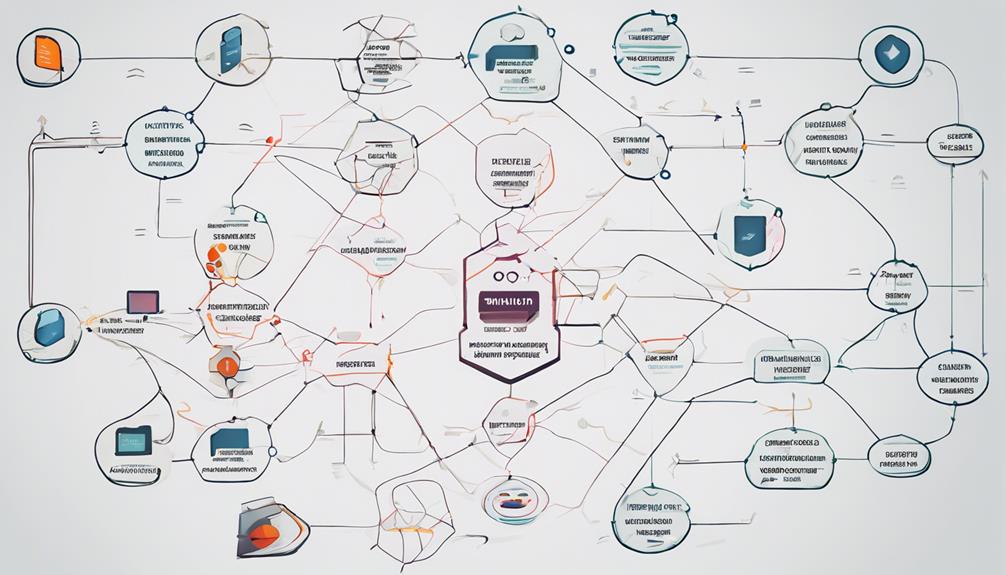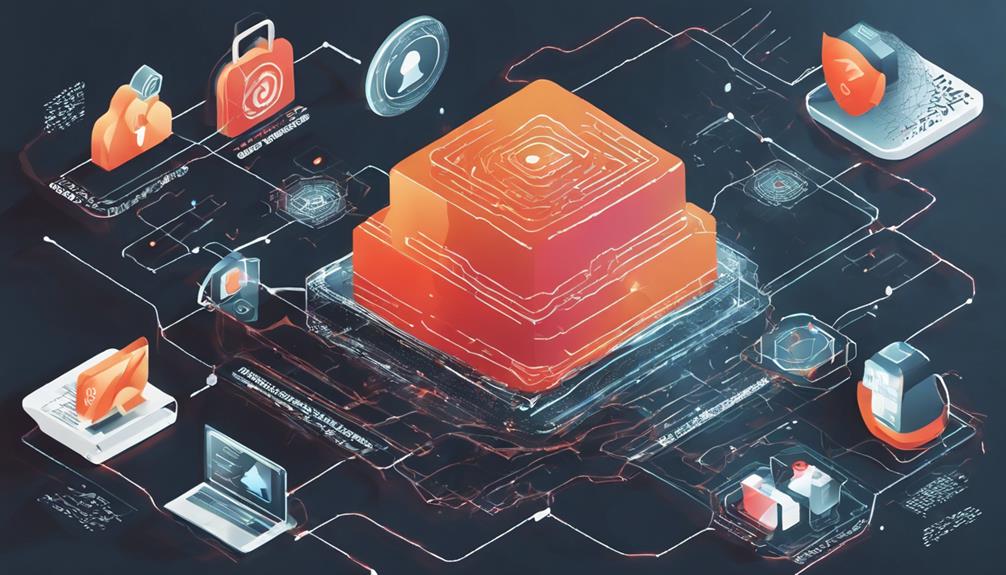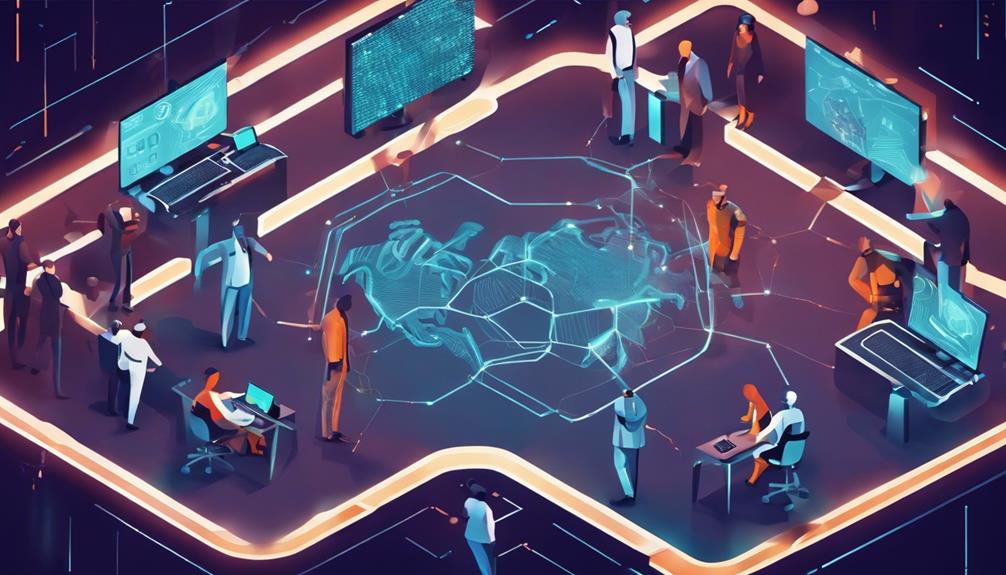Explore cutting-edge AI integration in cyber defense with our AI for Cyber Security Course. Gain advanced knowledge to tackle modern threats effectively with practical AI applications. Covering best practices, the course equips you to fortify digital environments using AI. Immerse yourself in the essentials of cyber security and AI to combat evolving threats. Enhance your skills through real-world scenarios and a capstone project. Explore AI-driven cyber defense strategies for valuable insights and expertise. Join us on this transformative journey into the future of cyber security.
Key Takeaways
- Equips with advanced AI tools for cyber defense.
- Covers AI data leakage management.
- Focuses on identifying and mitigating security threats.
- Offers hands-on labs for practical experience.
- Provides real-world scenarios for effective defense strategies.
Course Overview
The Course Overview offers a vital introduction to the integration of Artificial Intelligence (AI) in cyber security defense strategies. By delving into the domain of AI, students are equipped to tackle modern cyber threats with advanced knowledge and innovative solutions. This course not only covers cyber security best practices but also explores how AI can be effectively applied in defense strategies to mitigate threats effectively.
Understanding the fundamentals of cyber security and AI is essential in combating evolving threats. From analyzing attack/defense strategies to managing AI data leakage, students gain a thorough understanding of how AI can be leveraged to enhance security measures.
Additionally, the integration of AI into business processes and data models is explored, providing insights into how AI can fortify digital environments against potential threats.
Curriculum Highlights

Exploring the structure of the course, the Curriculum Highlights delineate key components that equip students with practical AI and cyber security knowledge. The curriculum includes AI Data Leakage Management, focusing on safeguarding sensitive information through the utilization of AI tools.
By gaining insights into AI fundamentals and their practical applications in cyber security, students are equipped to integrate AI into business processes and data models, enhancing overall security measures. A significant aspect of the course is the emphasis on understanding why Cyber Security is broken, enabling students to address vulnerabilities effectively.
Moreover, students will have the opportunity to work on a capstone project that synthesizes their cyber security and AI skills, providing a hands-on experience in applying the knowledge gained throughout the course. By immersing themselves in real-world scenarios, students can develop a deep understanding of how AI can be leveraged to fortify security measures and mitigate potential threats effectively.
Program Structure

The program structure of the AI for Cyber Security Course encompasses three key aspects:
- Course Modules Overview
- Learning Path Details
- Assessment and Certification
These components provide a thorough framework for participants to navigate through the course efficiently.
Course Modules Overview
Covering essential topics in AI-driven cyber security, the course consists of 3 modules that provide a thorough overview of key concepts and practical applications. These modules explore Artificial Intelligence (AI), Generative AI, and Machine Learning (ML) in the context of cybersecurity.
With a strong rating of 4.7 based on 15 reviews, the course investigates the exploitation of undetected vulnerabilities using AI and ML, User and Entity Behavior Analytics (UEBA), threat intelligence, and more.
Notably, the course includes hands-on labs and real-world exercises, catering to both existing cybersecurity professionals and beginners. Students can expect to gain practical experience in fine-tuning open-source Large Language Models (LLMs) for cyber defense.
The course's approximate duration is 9 hours, offering a flexible schedule for self-paced learning. By focusing on these modules, participants can acquire valuable insights and skills to navigate the complex landscape of AI-powered cyber defense effectively.
Learning Path Details
Throughout the program, participants will engage in a structured sequence of modules designed to enhance their understanding of AI-driven cyber security. The course offers a thorough approach to developing cybersecurity skills, focusing on defense strategies and security threats in various domains.
Participants will explore the role of artificial intelligence and advanced technologies in shaping cybersecurity policies and strategies.
Key components of the learning path include hands-on labs where students can apply theoretical knowledge to real-world scenarios. These labs provide a practical environment for participants to refine their skills in combating cyber threats effectively.
Assessment and Certification
The evaluation and certification framework within the program structure guarantees a thorough assessment of participants' knowledge and skills in AI-driven cyber security. With 8 assignments designed to evaluate knowledge acquisition, learners undergo a detailed evaluation process.
Successful completion of the AI for Cyber Security course culminates in the attainment of a shareable certificate, validating the individual's expertise in the field. The latest update in February 2024 confirms that the course remains aligned with current industry trends, equipping participants with relevant and cutting-edge knowledge.
Additionally, the high satisfaction rating of 4.7 out of 5 based on 15 reviews attests to the quality and effectiveness of the course content. Furthermore, the program offers flexible scheduling and self-paced learning options, accommodating diverse preferences and availability.
Through these assessments and certifications, participants can enhance their proficiency in AI-driven cyber security and advance their careers in this dynamic and important field.
Course Objectives

Exploring the course objectives of the AI for Cyber Security course investigates the foundational aspects of AI in preventing security vulnerabilities.
In this course, participants will explore the world of cybersecurity, focusing on identifying and mitigating security threats through the application of artificial intelligence. By understanding how AI can be leveraged to enhance cyber defenses, individuals will acquire the skills necessary to operate as Junior Analysts in the cybersecurity field.
Moreover, the program aims to equip students with essential business skills relevant to the ever-evolving cyber landscape, enabling them to bridge the gap between cybersecurity and AI strategies effectively. Through practical exercises and theoretical knowledge, learners will learn to connect the dots between various cybersecurity components and AI technologies.
Ultimately, the course's objective is to provide participants with employable skills that will prepare them for future roles in cybersecurity, where the integration of AI is becoming increasingly essential for robust defense strategies.
Value Proposition

In light of the advanced knowledge and practical skills acquired in AI for Cyber Security, the value proposition of the course lies in empowering individuals to deploy cutting-edge Generative AI and Large Language Models for robust cyber defense strategies.
By delving into the intricacies of cyber defense, participants will gain a deep understanding of how to leverage Large Language Models (LLMs) to fortify digital environments against evolving threats.
The course equips learners with the expertise to implement advanced Generative AI techniques, including LLMs, to detect and mitigate security vulnerabilities effectively.
Through a thorough exploration of architecture design patterns and technology stacks specific to Generative AI in cybersecurity, students will develop the proficiency needed to enhance organizational resilience in the face of sophisticated cyber attacks.
Delivery Model

The AI for Cyber Security Course offers a dynamic learning experience through:
- Interactive virtual labs
- Real-world case studies
- Online learning advantages
Students engage in live teacher-led virtual sessions in small teams, fostering a collaborative environment for personalized learning.
The curriculum emphasizes technical, interpersonal, and business skills essential for success in the field of cyber security.
Online Learning Advantages
Implementing a live teacher-taught virtual format in small teams promotes personalized learning in the AI for Cyber Security course. This online learning approach allows students to closely engage with instructors and peers, enhancing their understanding of complex Cyber Security concepts. With a course duration of 13 weeks and 10-20 students per team, participants benefit from increased engagement and individualized attention.
The blend of technical, interpersonal, and business skills training guarantees a well-rounded educational experience, preparing students for diverse challenges in the field. Furthermore, the integration of simulated work environments provides practical scenarios that mirror real-world Cyber Security situations. This hands-on approach allows students to apply their knowledge in a safe setting, sharpening their problem-solving skills effectively.
The team-based learning environment further fosters collaboration and mutual support among participants, cultivating a sense of community and shared learning. Overall, the online learning advantages of this course offer a thorough and immersive educational experience for aspiring Cyber Security professionals.
Interactive Virtual Labs
To enhance the experiential learning aspect of the AI for Cyber Security course, the interactive virtual labs serve as practical environments for students to apply and reinforce their understanding of AI cyber security concepts. These labs offer hands-on experience in dealing with cyber threats through simulated work environments. Small team settings within the virtual labs encourage collaborative learning and provide support for students as they navigate realistic scenarios to develop skills in defending against cyber threats. The interactive virtual labs focus on experiential learning, allowing students to engage in practical exercises that solidify their comprehension of AI cyber security principles.
| Features of Interactive Virtual Labs | Benefits |
|---|---|
| Hands-on experience | Practical application of concepts |
| Small team settings | Collaborative learning environment |
| Realistic scenarios | Skill development in defending against cyber threats |
Real-World Case Studies
Exploring real-world case studies within the delivery model of the AI for Cyber Security course offers students practical insights into the application of Generative AI in cybersecurity scenarios. Through hands-on demonstrations and lessons focused on Large Language Models (LLMs), participants gain valuable experience in fine-tuning these models for cyber defense purposes.
Led by expert instructor Ken Huang, renowned in both Generative AI and cybersecurity fields, the course provides a thorough understanding of how AI can be effectively leveraged to enhance security measures.
With a course rating averaging 63% based on 27 reviews, positive feedback highlights the practical videos and real-life examples incorporated into the curriculum. By delving into case studies that showcase the real-world application of LLMs in cybersecurity contexts, students are equipped with the knowledge and skills necessary to tackle contemporary cyber threats effectively.
Upon completion, learners receive a certificate of achievement and gain access to EC-Council Pro's extensive library of over 500 courses for just $59.99/month, ensuring continued professional development in the cybersecurity domain.
Benefits Overview

The AI for Cyber Security Course offers a thorough overview of the benefits it provides to students seeking to enhance their skills and knowledge in the field of cybersecurity. As the future of cybersecurity evolves rapidly, this course equips learners with the technical, interpersonal, and business skills essential for securing digital environments.
One key advantage is the live teacher-led virtual sessions, fostering a collaborative learning environment with small teams of 10-20 students, ensuring personalized attention and support.
Moreover, the course stands out by offering realistic simulated work environments where students can engage in hands-on learning, preparing them for real-world challenges in cybersecurity roles. By emphasizing team-based learning, participants not only gain technical expertise but also develop critical teamwork and communication skills important in the security industry.
Ultimately, this course equips students with the employable skills needed for the dynamic landscape of future cybersecurity roles, making it a valuable investment in their professional development.
Start Date & Fees

Commencing with the course details, the Start Date & Fees for the AI for Cyber Security Course provide vital information for interested participants.
- Start Date: The course has rolling admissions, allowing participants to start at their convenience.
- Course Cost: Priced at $99.99, the course offers a 6-hour duration, ideal for those looking to enhance their cybersecurity skills.
- Virtual & In-Residence Structure: The course is structured over four weeks, with a two-week virtual component followed by a two-week, in-person session for a thorough learning experience.
- Skill Level Requirement: Participants are expected to have an advanced skill level with prerequisites in both cybersecurity concepts and AI knowledge to maximize learning outcomes.
These details make sure that individuals can plan accordingly and understand the financial commitment required to undertake this advanced cybersecurity course led by industry expert Ken Huang.
Frequently Asked Questions
How AI Can Be Used in Cyber Security Defences?
AI is instrumental in cyber security defenses by leveraging machine learning algorithms to analyze data for threat detection, automate tasks, and enhance capabilities for identifying vulnerabilities. It provides real-time insights and predictive analysis to proactively defend against cyber attacks.
Is AI Going to Replace Cyber Security?
AI is not set to replace cyber security; rather, it serves as a force multiplier. By enhancing threat detection and response capabilities, AI augments traditional security measures. Its integration aims to bolster overall security posture and resilience against cyber threats.
Which Is Better for Future AI or Cyber Security?
In the evolving digital landscape, both AI and Cyber Security are essential for future defense. While AI enhances threat detection and response capabilities, Cyber Security focuses on protecting digital assets. Synergizing both fields creates robust defense mechanisms against cyber threats.
Can I Combine AI and Cyber Security?
Combining AI and cyber security is highly beneficial as AI can enhance threat detection, automate response mechanisms, and bolster overall defense strategies. The integration of AI technologies into cyber security practices can greatly improve protection against evolving digital threats.
Conclusion
In mastering the future of cyber defense with the AI for Cyber Security course, individuals can gain essential skills to protect against evolving threats.
This program offers a thorough curriculum, structured for success in the field. By enrolling, participants can enhance their knowledge and expertise in cybersecurity, positioning themselves as valuable assets in the digital landscape.
Embrace the opportunity to stay ahead of cyber threats and secure a successful future in the ever-changing cybersecurity field.









